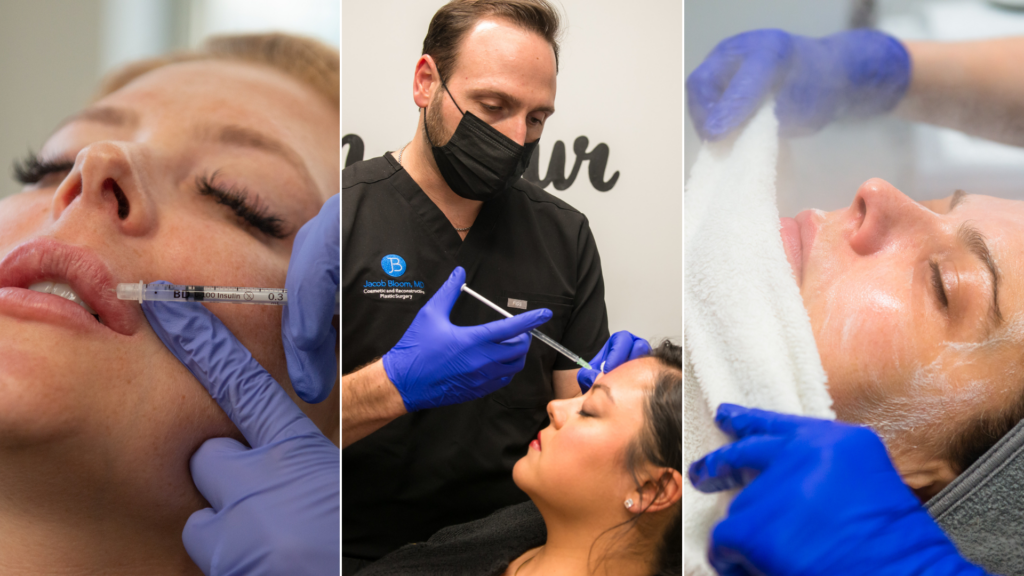Summer is a season of fun-filled adventures and memorable moments spent under the warm sun. It’s also a time when we want to look and feel our best, whether it’s lounging on the beach or attending social events. If you’re considering aesthetic cosmetic treatments to enhance your appearance, it’s essential to choose procedures that are suitable for the summer season. In this blog, we’ll explore the ideal treatments to consider during the summer months and those that are best reserved for fall or winter.

Ideal Summer Cosmetic Treatments
Botox
What makes Botox and Dysport particularly appealing is their safety, minimal discomfort, and convenience. Administered in a medical office setting, these treatments typically take less than 30 minutes to complete and require little to no recovery time. Moreover, contrary to common misconception, these treatments do not make the skin more sensitive to sun exposure. And — botox isn’t only for women. Men can benefit from botox as well!
The results of Botox and Dysport become noticeable within approximately one month after the procedure, and the effects can last throughout the summer, offering up to 6 months of wrinkle-free rejuvenation. This means that with a single treatment, you can confidently enjoy the sunny days without the worry of static wrinkles spoiling your appearance.
It’s important to note that Botox and Dysport are not permanent solutions and will gradually wear off over time. However, their longevity makes them particularly well-suited for summer, as you can enjoy the benefits of the treatment for the entire season without needing touch-up sessions.
DiamondGlow Hydrafacial
DiamondGlow is one of the most common procedures performed year-round. It is especially popular during the summer months due to its ability to hydrate, nourish, reverse sun damage, clear pores, and provide anti-aging benefits. Its customizable nature makes it suitable for a wide range of patients, catering to specific skin concerns.
The summer heat and sun exposure can leave the skin dehydrated and lacking essential nutrients. A hydrafacial is specifically designed to replenish moisture and deliver nourishing ingredients to the skin. Through a multi-step process involving cleansing, exfoliation, extraction, and infusion of serums, the hydrafacial deeply hydrates the skin, restoring its natural moisture balance and promoting a healthy, radiant complexion.
Dermal Fillers
Dermal fillers are popular cosmetic treatments that can effectively address various concerns in the soft tissues of the face. Whether you desire smoother skin, more defined cheekbones, or fuller lips, dermal fillers can help you achieve your desired aesthetic goals.
One type of dermal filler commonly used is hyaluronic acid fillers. These fillers work by stimulating the body’s natural collagen production, resulting in improved skin elasticity and a more youthful appearance. Importantly, hyaluronic acid fillers do not increase the skin’s sensitivity to UV light, making them suitable for use during the summer months.
Similar to Botox, dermal filler treatments are considered safe and are typically performed as quick in-office appointments. The procedure itself is relatively straightforward and can be completed within a short amount of time. Following the treatment, most individuals experience little to no downtime, allowing them to resume their daily activities without significant interruption.
Dermal fillers offer versatility in addressing a wide range of concerns. They can effectively fill in wrinkles and fine lines, restore volume to areas that have experienced age-related volume loss, and enhance specific features like the cheekbones or lips. The results of dermal filler treatments are often immediate, allowing you to enjoy the benefits soon after the procedure.
It is important to note that the longevity of dermal fillers varies depending on factors such as the type of filler used and individual metabolism. While the effects are not permanent, they typically last several months, making them a convenient option for those seeking temporary enhancements during the summer season.
Cosmetic Procedures to Avoid During Summer
While there are various cosmetic treatments that can be performed during the summer season, there are some procedures that are best avoided due to potential complications related to sun exposure and heat. Here is a list of cosmetic treatments to avoid during the summer:
Chemical Peels
Chemical peels are effective for addressing various skin concerns, including uneven texture, fine lines, and hyperpigmentation. However, the exfoliating nature of chemical peels can leave the skin more sensitive to the sun. The healing process after a chemical peel involves skin regeneration. During this time, it’s important to protect the treated area from direct sunlight. Therefore, it is generally recommended to undergo chemical peel treatments during the fall or winter months.
Microneedling
Microneedling is a collagen-stimulating treatment that helps improve skin texture, fine lines, and acne scars. The procedure involves creating micro-injuries on the skin’s surface, which can increase sensitivity to the sun. To ensure optimal healing and minimize the risk of complications, it’s advisable to avoid microneedling during the summer months.
Surgical Procedures
Invasive cosmetic surgeries, such as facelifts, breast augmentations, and body contouring surgeries, typically involve extended recovery periods. During this time, it is crucial to protect incision sites from sun exposure and limit physical activities that may increase the risk of complications. To ensure a smooth recovery and minimize potential risks, it’s generally best to schedule these procedures during fall or winter.
It’s important to note that individual recommendations may vary. It’s always best to consult with a qualified medical professional or plastic surgeon. We can provide personalized advice based on your specific needs and circumstances. Our team at Bloom Plastic Surgery is here to guide you on the appropriate timing for cosmetic treatments to ensure optimal results and minimize any potential risks.
